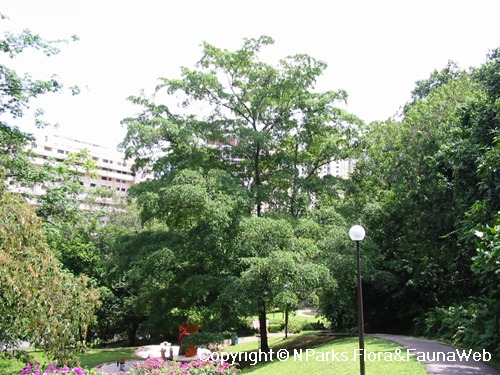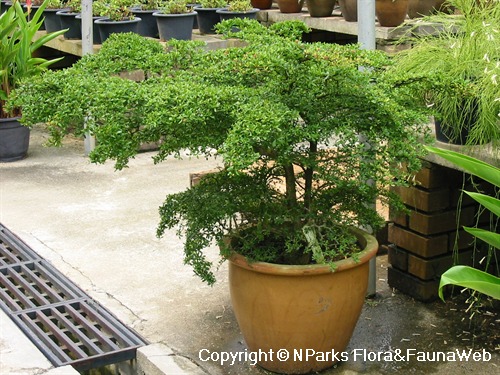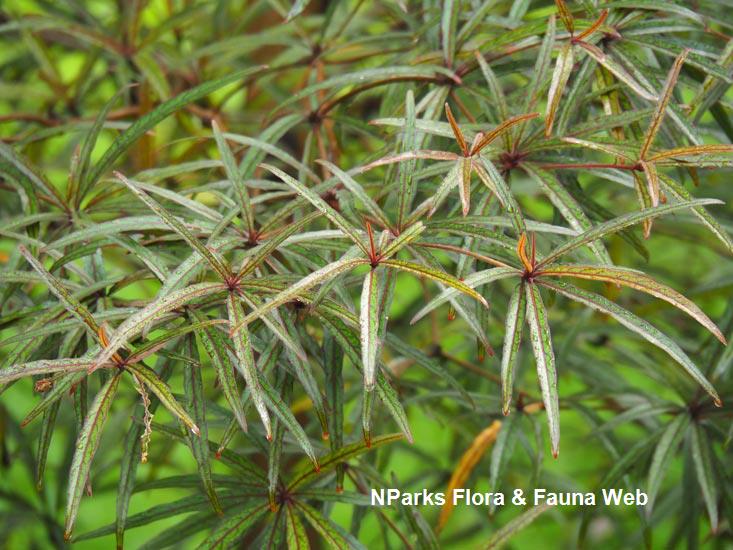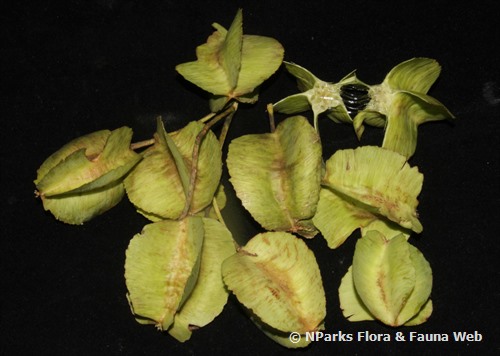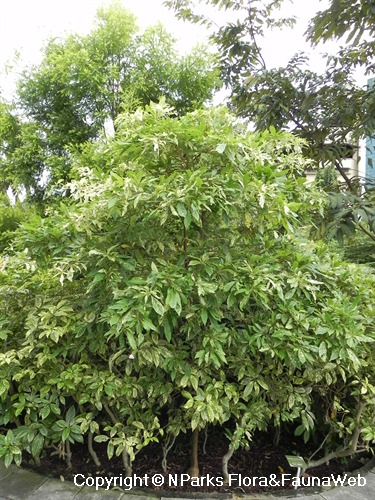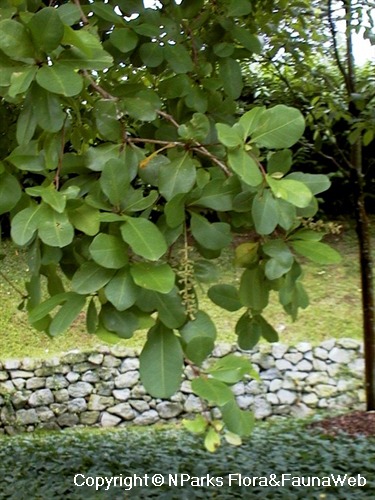
Back
Terminalia buceras (L.) C. Wright
| Family Name: | Combretaceae |
| Synonyms: | Buceras bucida Crantz, Bucida ophiticola Bisse, Bucida subinermis Bisse |
| Common Name: | Black Olive, Olive-bark Tree |
Terminalia buceras, also known as Black Olive, is a semi-deciduous tree, up to 40 m tall. The flowers are white to cream coloured and strongly scented. The bark is used in Puerto Rico and Jamaica for tanning purposes.
Name
Classifications and Characteristics
| Plant Division | Angiosperms (Flowering Seed Plants) (Dicotyledon) |
|---|---|
| Plant Growth Form | Tree |
| Lifespan (in Singapore) | Perennial |
| Mode of Nutrition | Autotrophic |
| Plant Shape | Tiered |
| Maximum Height | 40 m |
Biogeography
| Native Distribution | Central and South America |
|---|---|
| Native Habitat | Terrestrial |
| Preferred Climate Zone | Tropical |
| Local Conservation Status | Non-native |
Description and Ethnobotany
| Growth Form | It is a semi-deciduous tree, 3.5 – 40 m tall. Spines may be present on the branches, especially when the tree is young. |
|---|---|
| Foliage | Leaves are spirally arranged and tend to cluster at the tip of the branch. The leaves are oval-shaped (2 – 11 cm long and 1 – 6.7 cm wide), and leathery. The leaf margin may roll slightly downwards (revolute). Leaf tip is rounded to notched (retuse) while leaf base is cuneate. Petiole is 0.2 – 1.2 cm long and usually with glands. Domatia is absent. |
| Flowers | Inflorescence is a spike, about (2.5) – 4 – 19 cm long, and consist of many small and sessile flowers. The flowers are white to cream coloured and strongly scented. Each flower is bisexual, with 4 – 5 calyx lobes, whorled stamens and hairy hypanthium. |
| Fruit | Fruit is woody, achene-like and oval shaped with a beak at the tip. They are borne on a stalk which is about 0.4 – 0.7 cm long and 0.2 – 0.45 cm wide. |
| Habitat | It is found in secondary forests, shrubland, savannas, coastal forest, swampy forest and on limestone, up to 1200 m altitude. |
| Cultivation | It may develop galls that resemble bull’s horn if it is infected with Eriophyid mites. |
| Etymology | Terminalia, in Latin, refers to the plant’s leaves that are clustered at the end of end of the twigs. Buceras, in Latin, refers to the narrowly curved galls which resembles bull’s horn. |
| Ethnobotanical Uses | Others: In Puerto Rico and Jamaica, the bark is used for tanning purposes. It is also used externally on wounds to stop bleeding. The timber is said to be valuable. |
Landscaping Features
| Desirable Plant Features | Fragrant |
|---|---|
| Landscape Uses | Suitable for Roadsides |
| Usage Hazard - Cons Remarks | Various parts of the plant contain tannic acid which may stain the pavements when dropped. |
Fauna, Pollination and Dispersal
| Fauna Pollination Dispersal Associated Fauna | Butterfly-Attracting |
|---|
Plant Care and Propagation
| Light Preference | Full Sun |
|---|---|
| Water Preference | Moderate Water |
| Plant Growth Rate | Moderate |
| Rootzone Tolerance | Well-Drained Soils |
| Diseases | It may develop galls that resemble bull’s horn if it is infected with Eriophyid mites. |
Foliar
| Foliage Retention | Drought / Semi-Deciduous |
|---|---|
| Mature Foliage Colour(s) | Green |
| Leaf Area Index (LAI) for Green Plot Ratio | 3.0 (Tree - Intermediate Canopy) |
Floral (Angiosperm)
| Flower Colour(s) | Cream / Off-White, Green |
|---|
References
| References | Stace, C.A. and Abdul-Ridha Alwan (2010). Combretaceae. Flora Neotropica, Vol. 107, pp. 1-369 |
|---|
Image Repository
Others
| Master ID | 1468 |
|---|---|
| Species ID | 2761 |
| Flora Disclaimer | The information in this website has been compiled from reliable sources, such as reference works on medicinal plants. It is not a substitute for medical advice or treatment and NParks does not purport to provide any medical advice. Readers should always consult his/her physician before using or consuming a plant for medicinal purposes. |

